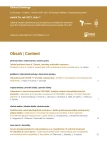Adherence to non-pharmacological procedures in the treatment of postmenopausal osteoporosis: a pilot study
Authors:
Kuriplachová Gabriela 1; Kendrová Demjanovič Lucia 2; Lengyelová Andrea 1; Cibríková Silvia 1; Nechvátal Pavol 2; Pavúková Martina 1
Authors‘ workplace:
Katedra ošetrovateľstva, Fakulta zdravotníckych odborov Prešovskej univerzity v Prešove
1; Katedra fyzioterapie, Fakulta zdravotníckych odborov Prešovskej univerzity v Prešove
2
Published in:
Clinical Osteology 2021; 26(1): 15-21
Category:
Overview
Aim: The aim of this multicenter cross-sectional study was to identify significant differences in adherence to recommended non-pharmacological procedures in postmenopausal women depending on age, BMI (Body Mass Index) and duration of treatment. Methods: In the year 2018, the study was carried out in three health centers in Slovakia. It was attended by 174 respondents (women) aged 52–75 years (SD ± 6.31). Inclusive criteria for inclusion of respondents in the study were postmenopause and postmenopausal osteoporosis, diagnosed based on BMD (Bone Mineral Density) values. Data were collected by an initial anamnestic interview, which were supplemented by anthropometric measurements. A non-standardized questionnaire with a Likert scale from 1–5 points was used to determine the respondent´s attitudes towards adherence to non-pharmacological procedures. ANOVA test was used for statistical comparison of data. Spearman´s correlation analysis was used to determine significant correlations between variables. Results: The study found weak correlation between BMI and eating habits (r = 0.17; p = 0.02) and weak correlation between age and adequate alcohol consumption (r = 0.20; p = 0.01). The duration of treatment of the disease did not affect adherence to non-pharmacological procedures. Conclusion: In view of the results obtained a deeper examination of the issue with a larger age range of women is required. Focusing on the types of fitness exercises in the treatment of postmenopausal osteoporosis and their protective significance for health could be the subject of further research.
Keywords:
fracture risk – non-pharmacological treatment – osteoporosis – prevention – risk factors
Sources
- Jackuliak P. Základné princípy osteoporózy. In: Payer J, Borovský M et al. Osteoporóza pri vybraných ochoreniach. Herba: Bratislava 2014 : 13–41. ISBN 978–80–89631–19–3.
- Sotorník I. Osteoporóza – epidemiologie a patogeneze. Vnitř Lék 2016; 62(Suppl 6): 84–87.
- Běhounek J. Přehled nefarmakologické prevence zlomeniny v terénu osteopatií se zaměřením na fyzickou zátěž. Clin Osteol 2019; 24(3): 101–106.
- Payer J, Killinger Z, Jackuliak P et al. Postmenopauzálna osteoporóza: štandardný diagnostický a terapeutický postup. Clin Osteol 2018; 23(1): 18–27.
- Kolařík D, Halaška M, Feyereisl J. Repetitorium gynekologie. 2. ed. Maxdorf: Praha 2011. ISBN 978–80–7345–267–4.
- Nútite R, Brandi ML, Checchia G. Guidelines for the management of osteoporosis and fragility fractures. Intern Emerg Med 2019; 14(1): 85–102. Dostupné z DOI: <http://doi: 10.1007 / s11739–018–1874–2>.
- Killinger Z, Lalciková E, Payer J. Diagnostika osteoporózy. Via Pract 2013; 10(3–4): 92–94.
- Kužma M, Jackuliak P, Killinger Z et al. Vyšetrovacie metódy v osteológii. Univerzita Komenského v Bratislave: Bratislava 2018. ISBN 978–80–223–4520–0.
- Kanis JA, Cooper C, Rizzoli R et al. European guidance for the diagnosis and management of osteoporosis in postmenopausal women. Osteoporos Int 2019; 30(1): 3–44. Dostupné z DOI: <http://doi: 10.1007/s00198–018–4704–5>.
- Štěpán J. Osteoporóza u mužů. Čas Lék Čes 2016; 155(7): 340–348.
- Špániková B. Sekundárna osteoporóza pri nádorových ochoreniach. Clin Osteol 2018; 23(1): 9–17.
- Rosa J. Diagnostika a léčba postmenopauzální osteoporózy. Osteol Bull 2015; 20(4): 150–168.
- Sinaki M, Itoj E, Wahner HW et al. Stronger back muscles reduce the incidence of vertebral fractures. A prospective 10 year follow-up of postmenopausal women. Bone 2002; 30(6): 836–841. Dostupmé z DOI: <http://dx.doi.org/10.1016/s8756–3282(02)00739–1>.
- Hurley BF, Hanson ED, Sheaff AK. Strength training as a countermeasure to aging muscle and chronic disease. Sports Med 2011; 41(4):289–306. Dostupné z DOI: <http://dx.doi.org/10.2165/11585920–000000000–00000>.
- Kanis JA, Johnell O, De Laet C et al. A meta-analysis of previous fracture and subsequent fracture risk. Bone 2004; 35(2): 375–382. Dostupné z DOI: <http://dx.doi.org/10.1016/j.bone.2004.03.024>.
- Bužga M, Šmajstrla V, Bortlík L et al. Překvapivě nízka kostní denzita u obézních pacientů podstupujících bariatrický chirurgický výkon. Osteol Bull 2012; 17(2): 43–49.
- Tomková S, Vrško M. Osteoporóza u mužov: čo sa zmenilo? Clin Osteol 2019; 24(3): 93–100.
- Blažková Š, Vytřísalová M, Štěpán J et al. Secondary prevention of osteoporosis among general practitioners. Osteol Bull 2012; 17(1):32–35.
- Křivohlavý J. Kompliance – dodržování lékařových příkazů pacientem. Prakt Lék 2000; 80(5): 272–275.
- Magurová D, Majerníková Ľ. Teoretické východiská edukácie v zdravotníckej praxi. A-print: Lipovce 2016. ISBN 978–80–89721–13–9.
Labels
Clinical biochemistry Paediatric gynaecology Paediatric radiology Paediatric rheumatology Endocrinology Gynaecology and obstetrics Internal medicine Orthopaedics General practitioner for adults Radiodiagnostics Rehabilitation Rheumatology Traumatology OsteologyArticle was published in
Clinical Osteology

2021 Issue 1
- Advances in the Treatment of Myasthenia Gravis on the Horizon
- Metamizole at a Glance and in Practice – Effective Non-Opioid Analgesic for All Ages
- Memantine in Dementia Therapy – Current Findings and Possible Future Applications
- Metamizole in perioperative treatment in children under 14 years – results of a questionnaire survey from practice
Most read in this issue
- Relapsing hypercalcemia – a hard diagnostic nut to crack: a case report
- Pseudohypoparathyroidism type Ib: a case report and review of literature
- Osteoporosis associated with pregnancy: a case report
- Steel syndrome – the first case of rare skeletal dysplasia in Slovakia: a case report
